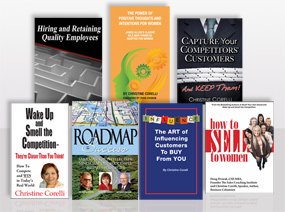
When you think of the word “conflict” you likely associate it with the words friction, disharmony, rivalry, disagreement, clash, dissonance, disunity, and yes…stress. “Not seeing eye-to-eye” might come to mind as well. None of these conditions are healthy, but they are not uncommon in any organization.
Get Real
Realistically, a business or a life without conflict is a pipe dream! We don’t live in a perfect world. There are no perfect people, perfect teams, or perfect companies. But when conflict occurs or exists in the workplace, it must be resolved. If it is not, it can to negative and unproductive consequences – anxiety, victimization, anger, intimidation, blame, resentment, morale problems, even power plays that intensify problems and waste time and energy. This holds true whether a conflict exists between two individuals, teams, or even between departments or branches.
What happens if you ignore the conflict
Not being willing to resolve conflict can make the problem fester, destroy relationships and create an unhealthy work environment. Even if the conflict is just between two individuals, it makes others uncomfortable and tends to create a negative work environment.
Good News
The good news is that most conflict can be resolved and worked out in mutually satisfactory ways. Often, there are workable options that an individual will not even see until they become open to the concept of working through the conflict, rather than allowing problems and people to fester. It can even be a healthy way to bring important issues to light and strengthen relationships.
Common Causes
Common causes of conflict in the workplace are rarely about things. Most are about respect. For example, if you or anyone in your company has experienced any of these feelings you will have a conflict situation.
- “My right to decide is being weakened.”
- “I feel taken for granted.”
- “My right to control is being jeopardized.”
- “Why should I say anything? It doesn’t do any good.”
- “My judgment and my ideas are not being considered.”
- “I never get credit for anything.”
- “My prestige and my status are being questioned.”
- “I never feel I am appreciated for anything.”
- “My feelings don’t count here.”
- “I feel unfairly treated, defeated, powerless, inferior.”
- “I know I’m right and they won’t listen to me.”
What do people do when they have any of these feelings? They either dig and their heels and fight, or they retreat. They stop coming forth with ideas. They go through the motions of their job and cease to put forth any real effort because they feel undervalued and underappreciated.
More Causes of Conflict – Personality Clashes
Sometimes, conflict can occur when there are personality clashes with people. One person may not like the other individual’s work style. Another cause can be a lack of understanding between left-brained and right-brained people. “Number’s Guys,” or analytical people may not be able to understand and relate to highly creative people. Jealousy over someone’s salary or someone else getting credit instead of the person who should get credit can also create conflict.
Your Culture, Itself can Cause Conflict
Far too often, today’s workplace environment triggers it. Think about your workplace. If any of these conditions exist, you don’t have a healthy work environment, and you do not have a workplace for high-performance, where teamwork, respect, and service excellence permeate your company.
- Too much competition and not collaboration, such as when successful branches do not share best practices or top sales pros don’t help new salespeople.
- Executive teams or employee teams that are not aligned with the priorities of the company
- “Territorialism” or “Us Vs. Them” mentality instead such as when parts and service don’t have each others’ best interest at heart.
- Negativity and bad attitudes that pull people down instead of having people who bring a positive attitude to work each day.
- Changes put into place and decisions being made without getting opinions of those that will be affected
- Personality clashes in the leadership team
- Favoritism from management instead of “We are all equals.”
- “Micro-managing,” instead of training to enable people, then trusting
- Under-performers who get away with doing only what is required, where top performers must take up the slack
- Too much “red-tape” instead of simple, and easy processes and procedures
- Lack of respect for others’ opinions, ideas, and feelings
- People who cannot adapt to change
Steps to handle conflict with another individual –
Sometimes it’s best to walk away until you calm down and think about how you will handle the conflict. Sometimes it’s handling a situation right on the spot. What is most important is to build and maintain relationships that work. This is important if the conflict has existed for a long while.
Step #1 – Manage Your State of Mind
To successfully resolve conflict open-minded, begin by willing to let go of blame or any issues from the past. Instead, focus on “fixing” the issue or relationship. Keep your emotions in control, and be willing to listen to the other person put yourself in their position.
Step #2 – Communicate with the other individual and in privacy.
Address the situation and be assertive. Not to be confused with aggressive people, assertive people have a high-affinity for themselves and for others. They know what they want, and how they feel. Most important, they know how to communicate those feelings to others in a non-combative manner. They are usually healthy both physically and mentally because they can express themselves and they rarely keep things inside. They have a high sense of self-esteem. Learn to be assertive, and learn how to communicate with tact and diplomacy.
Step #3 –Ask how you can make things better, or help the situation.
This may be the most important step. Stating with honesty and sincerity that you want to resolve the conflict situation, is vital to conflict resolution.
Step #4 – Listen
As you listen to the other person’s position. Demonstrate that you are listening. Interject with, “I see.” “I understand.”
Step #5 – Resolve!
Let the person know you have heard them and understand their position. Supply the answer, but in the form of a question.
- “What would happen if we can agree to…”
- “It would really help me if …”
- “How about if I work on __________ and if you will agree to…”
Step # 6 – Ask for cooperation-don’t demand it.
- “Can I rely on you to…”
- “Will you please?
- “It would really help me if…”
- “I would appreciate if you would…”
- “How about if we agree to…”
Step # 7 – Finish in a friendly fashion.
- Reaffirm your support and ask for theirs.
- “I’m glad we had this talk. Can we agree to…”
- ” I appreciate your cooperation.”
- “I’m confident we can…”
- “Let’s both try…”
Managing Conflict Between Departments or Teams
Encourage people to work through their conflicts in ways that work in your company’s best interest. Ask them to be open to negotiating conflicts and strive for balance.
Competition doesn’t work. No one wins.
Remind your people that competition is the least effective method of handling conflict. It is harmful because it intimidates people into agreement. Individuals can become engrossed in the conflict, and be unable to separate themselves from the situation.
Collaboration works for organizational success
Direct your team to collaborate as it is the best method of handling conflict. When people collaborate, there is a sense of trust, partnership, and coalitions that come into play. People are encouraged to generate potential solutions. Positions are not taken, but opinions are expressed. The conflict resolution process should be an open forum for the exchange of ideas and information. Most important, instruct them to share their thoughts, feelings, and experiences. Remind them to not be afraid to put themselves in a vulnerable situation, because they need to consider your organization’s success and a great place to come to work each day should be their main goal.
10 Keys to Avoid Conflict in Your Culture
Avoid conflict situations in your culture with these ten keys:
1. Everything starts and stops with leadership. Your entire leadership team should be trained in how to display dynamic leadership and treat every employee as well as they treat your best customers. Agree that no favoritism shall be displayed and that they spend significant time to help every employee perform their job role exceptionally well. Most important, employees should be appreciated on a regular if not daily basis. If you are a family-owned business, take off your “family” hat and display the same respect as you would if you were not relatives.
2. Hold regular phone conferences with branch managers to share.
3. Have your top salesperson facilitate a session to share how they are achieving success.
4. Train your staff on teamwork and customer service that includes internal customer service. Make sure each department understands each others’ pressures and how every individual department affects another.
5. Confront negative people and explain how negativity can hold back an entire team.
6. Ask for peoples’ opinions. This demonstrates that you respect them and helps to avoid conflict.
7. Hold weekly meetings with GM’s, Sales Managers, and Parts and Service Managers. Start your meeting with what went well the previous week, where improvement is needed, who is performing and who is not performing.
8. Nip problems in the bud. When any type of conflict occurs, handle it immediately. If you are experiencing conflict with an individual, set up a time to talk and follow the seven steps. Before you do, ask yourself if you are the problem.
9. Have your staff create “guiding principals” for how you will treat customers and each other in the workplace. Be sure to have them include – how to be proactive in solving problems and how to cut red tape.
10. Always know what’s going on in your company. That requires keeping your eyes and ears open, and asking these types of questions –
- “Is there anything I should know about?”
- “How is the new hire working out?”

- “How is your team performing?”
- “Is there anything I can do to help you?”
- “What should we be doing that we are not doing?”
The Bottom Line
Conflict can be resolved and even avoided if individuals have a sincere desire to do so. Letting little things go, turning the other cheek, accepting differences of opinions, letting go of the past, forgiving, compromising or at least meeting each other half-way, accepting people as they are, are just a few ways conflict can be resolved or even avoided between individuals.
Resolving conflict between departments and teams requires that you recognize your culture can make you or break you. Work toward creating the type of culture where people respect and love their immediate supervisor and enjoy coming to work each day.

